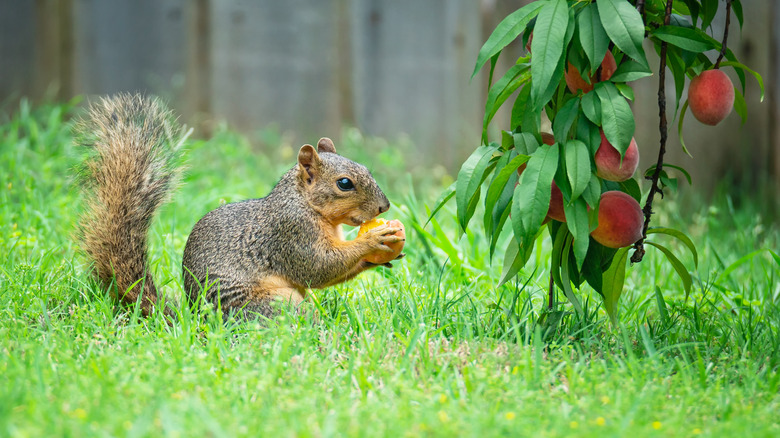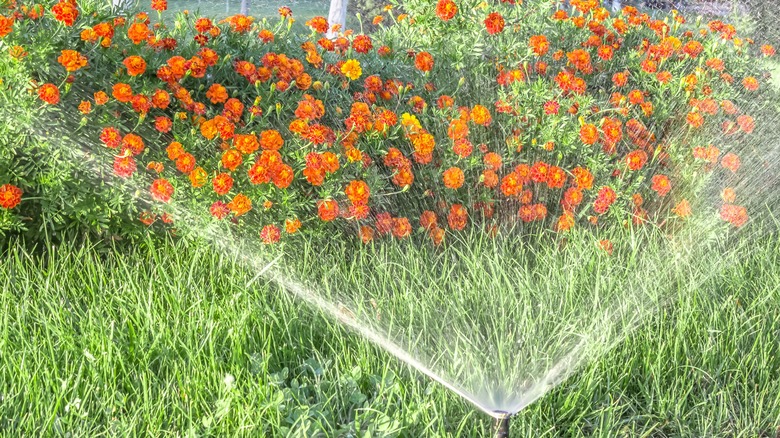The Easy Addition That Can Keep Squirrels From Even Thinking About Your Yard
We may receive a commission on purchases made from links.
Squirrels—the ebony-eyed acorn chasers—have rightly earned their infamy for leaving behind dug-up garden beds, half-nibbled nuts, and gnawed wires as they prance around your lawn with carefree abandon. You might've already tried humane solutions like vinegar, mint, and other DIY hacks to ward off these bushy-tailed invaders but achieved limited success. So, if you're looking for a foolproof way to get rid of squirrels, it's time to experiment with a new garden fixture — a motion sensor sprinkler.
Fairly popular for watering plants, a motion sensor sprinkler doubles as a frightening device that kicks into action when it senses the agile critters reaching out to your plants. Since squirrels are born skittish, it's easy to disarm them with a motion sprinkler system. Its built-in intelligent infrared sensors are incredibly sensitive to movements and immediately notice when the little rodent walks into its 30 to 40-foot-wide protective radius. Once the system activates, it makes whirring noises and squirts water across the area. Don't fret over the blast's pressure, though, as it's benign enough not to cause any injuries and will merely startle them. Luckily, this action is plenty to have them scampering away from your precious lawn.
Make sprinklers work for you
But you do need to care about the sprinkler's placement. While it's obvious you'd lodge it in common squirrel-lurking areas, such as around fruit trees and underneath bird feeders, ensure it faces the direction the pest is most likely to enter from. Also, steer clear of frequently-walked pavements and driveways that will have your system spurting water anytime you or a car pass by. An effective way to test it before fixing and connecting it to a hose, is to verify the sensor action by throwing a tennis ball.
Squirrels aside, the motion sensor sprinkler is equally useful for keeping other pests, including rabbits and deer away from your yard. So, installing it is akin to keeping almost all pesky invaders out. But if you only wish to target small rodents, choose a system with customizable options and raise its sensitivity to the highest level to capture their presence easily. The more expensive offerings are even armed with smart sensors that prevent them from going off with wind action and raising your water bills. While you're at it, also look at the spray range, as a larger span provides better protection but raises the risk of water getting into places you don't want it to. Spend some time evaluating the coverage, as most sprinklers limit themselves to about 1,000 to 1,600 square feet of area, making them inadequate for larger turfs unless you don't mind investing in multiple devices.
Other factors to consider
While generally affordable and costing under $80, a motion sensor sprinkler's price rises for additional features. For instance, you can choose to go hose-free if you can't plug the pipe into a water outlet and are okay with lugging around the system as needed. Similarly, if switching out batteries feels cumbersome, you can opt for more energy-efficient solar power systems, such as Hoont's Motion Activated Sprinkler for under $53 from Amazon, provided you get enough sun. But, if you need different power modes that empower you to dictate the system's operating timing, you can buy Orbit's Activated Sprinkler for under $76. If you don't want to suffer from early morning soaks while foraging for basil or want to let your pets walk around without a care, stick to night-only timings; otherwise, opt for either day-only or 24-hour timings.
Though an eco-friendly way to drive squirrels out, it may end up scaring birds away from your yard as well, so it's worth keeping in mind if you enjoy birdwatching. In addition, the motion sensor sprinkler has a hard time maintaining its long-term impact, even though many promise that given enough time, the bulb diggers will permanently transition out of your yard. However, the University of Florida insists otherwise and suggests switching out the sprinkler's positions periodically to keep the more adaptive or hungry squirrels out. You can further complement the water action with other methods like installing pinwheels or aluminum tins, at least in the newly planted gardens, to taper squirrel interest.


